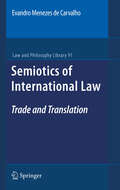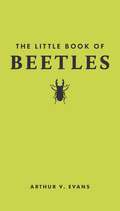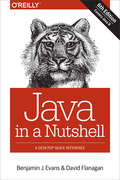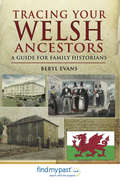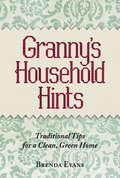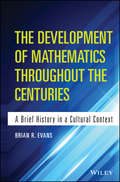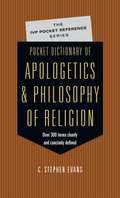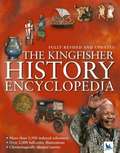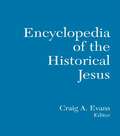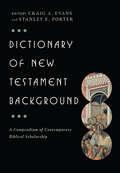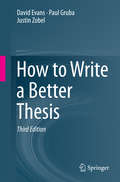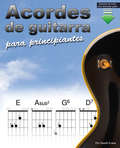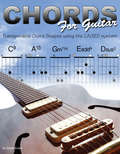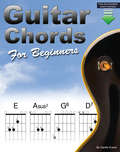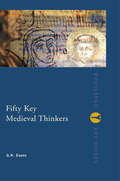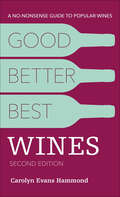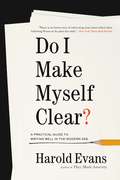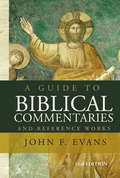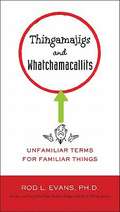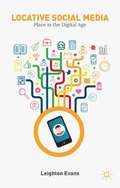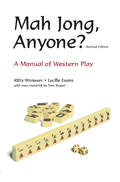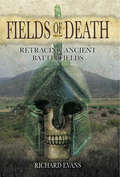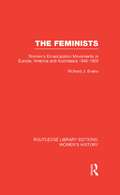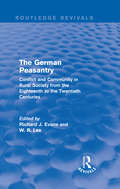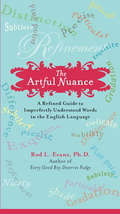- Table View
- List View
Semiotics of International Law
by Evandro Menezes de CarvalhoLanguage carries more than meanings; language conveys a means of conceiving the world. In this sense, national legal systems expressed through national languages organize the Law based on their own understanding of reality. International Law becomes, in this context, the meeting point where different legal cultures and different views of world intersect. The diversity of languages and legal systems can enrich the possibilities of understanding and developing international law, but it can also represent an instability and unsafety factor to the international scenario. This multilegal-system and multilingual scenario adds to the complexity of international law and poses new challenges. One of them is legal translation, which is a field of knowledge and professional skill that has not been the subject of theoretical thinking on the part of legal scholars. How to negotiate, draft or interpret an international treaty that mirrors what the parties, - who belong to different legal cultures and who, on many occasions, speak different mother tongues - ,want or wanted to say? By analyzing the decision-making process and the legal discourse adopted by the WTO's Appellate Body, this book highlights the active role of language in diplomatic negotiations and in interpreting international law. In addition, it also shows that the debate on the effectiveness and legitimacy of International Law cannot be separated from the linguistic issue.
The Little Book of Beetles (Little Books of Nature #2)
by Arthur V. EvansA charming, richly illustrated, pocket-size exploration of the world&’s beetlesPacked with surprising facts, this delightful and gorgeously designed book will beguile any nature lover. Expertly written and beautifully illustrated throughout with color photographs and original color artwork, The Little Book of Beetles is an accessible and enjoyable mini reference about the world&’s beetles, with examples drawn from across the globe. It fits an astonishing amount of information in a small package, covering a wide range of topics—from anatomy, diversity, and reproduction to habitat and conservation. It also includes curious facts and a section on beetles in myths, folklore, and modern culture from around the world. The result is an irresistible guide to the amazing lives of beetles.A beautifully designed pocket-size book with a foil-stamped cloth coverFeatures some 140 color illustrations and photosMakes a perfect gift
Java in a Nutshell
by Benjamin J Evans David FlanaganThe latest edition of Java in a Nutshell is designed to help experienced Java programmers get the most out of Java 7 and 8, but it's also a learning path for new developers. Chock full of examples that demonstrate how to take complete advantage of modern Java APIs and development best practices, the first section of this thoroughly updated book provides a fast-paced, no-fluff introduction to the Java programming language and the core runtime aspects of the Java platform.The second section is a reference to core concepts and APIs that shows you how to perform real programming work in the Java environment.Get up to speed on language details, including Java 8 changesLearn object-oriented programming, using basic Java syntaxExplore generics, enumerations, annotations, and lambda expressionsUnderstand basic techniques used in object-oriented designExamine concurrency and memory, and how they're intertwinedWork with Java collections and handle common data formatsDelve into Java's latest I/O APIs, including asynchronous channelsUse Nashorn to execute JavaScript on the Java Virtual MachineBecome familiar with development tools in OpenJDK
Tracing Your Welsh Ancestors: A Guide For Family Historians (Tracing Your Ancestors)
by Beryl EvansFew previous publications have focused on Welsh family history, and none have provided a comprehensive guide to the genealogical information available and where to find it. That is why the publication of Beryl Evans's new Welsh family history handbook is such a significant event in the field. Her detailed, accessible, authoritative guide will be essential reading and reference for anyone who is eager to research ancestors from Wales. She describes the key archival sources and shows how the development of new technology, the internet in particular, has made them so much easier to explore. Drawing on her long experience of family history work, she gives clear practical advice on how to start a research project, and she sketches in the outlines of Welsh history, Welsh surnames and place-names and the Welsh language. But the main body of her book is devoted to identifying the variety of sources researchers can consult the archive repositories, including The National Library of Wales, civil records of all kinds, the census, parish registers, wills, the records of churches, chapels, schools, businesses, tax offices and courts, and the wide range of printed records. Beryl Evans's handbook will be a basic text for researchers of Welsh descent and for anyone who is keen to learn about Welsh history
Granny's Household Hints: Traditional Tips for a Clean, Green Home
by Brenda EvansIn Granny's day there were few labour-saving devices or fancy cleaning products. So when it comes to getting stains out of the carpet or keeping her laundry sparkling white, she still prefers tried-and-tested techniques handed down through the generations. Many people nowadays would prefer to use natural, traditional cleaning methods, rather than chemicals that can be harmful to our health and the environment. So why not follow in Granny's footsteps and try her effective, green and surprisingly simple household hints? Learn how to keep your home spotless using common ingredients found in your kitchen cupboard, like lemon juice or bicarbonate of soda. You'll be helping the planet and your wallet too ... Granny would be proud!
The Development of Mathematics Throughout the Centuries: A Brief History in a Cultural Context
by Brian EvansThroughout the book, readers take a journey throughout time and observe how people around the world have understood these patterns of quantity, structure, and dimension around them. The Development of Mathematics Throughout the Centuries: A Brief History in a Cultural Contex provides a brief overview of the history of mathematics in a very straightforward and understandable manner and also addresses major findings that influenced the development of mathematics as a coherent discipline. This book: Highlights the contributions made by various world cultures including African, Egyptian, Babylonian, Chinese, Indian, Islamic, and pre-Columbian American mathematics Features an approach that is not too rigorous and is ideal for a one-semester course of the history of mathematics. Includes a Resources and Recommended Reading section for further exploration and has been extensively classroom-tested
Pocket Dictionary of Apologetics & Philosophy of Religion
by C. Stephen EvansThe Pocket Dictionary of Apologetics Philosophy of Religion is designed to be a companion to your study of these two related disciplines. Terms, from a posteriori to worldview, Apologists, from Abelard to Van Til, Philosophers of religion, from Alston to Wolterstorff, Movements, from analytic philosophy to voluntarism, Apologetic arguments, from the cosmological to the wager, Theologies, from Arminianism to Zoroastrianism.
The Kingfisher History Encyclopedia
by Charlotte EvansOften, fact is stranger than fiction. This Kingfisher History Encyclopedia is packed full of fascinating facts and real-life stories about the people, places, and events of the past that have shaped the colorful, but still turbulent world that we know today.
The Routledge Encyclopedia of the Historical Jesus
by Craig A. EvansThis Encyclopedia brings together the vast array of historical research into the reality of the man, the teachings, the acts, and the events ascribed to him that have served as the foundational story of one of the world's central religions. This kind of historiography is not biography. The historical study of the Jesus stories and the transmission of these stories through time have been of seminal importance to historians of religion. Critical historical examination has provided a way for scholars of Christianity for centuries to analyze the roots of legend and religion in a way that allows scholars an escape from the confines of dogma, belief, and theological interpretation. In recent years, historical Jesus studies have opened up important discussions concerning anti-Semitism and early Christianity and the political and ideological filtering of the Jesus story of early Christianity through the Roman empire and beyond. Entries will cover the classical studies that initiated the new historiography, the theoretical discussions about authenticating the historical record, the examination of sources that have led to the western understanding of Jesus' teachings and disseminated myth of the events concerning Jesus' birth and death. Subject areas include: the history of the historical study of the New Testament: major contributors and their works theoretical issues and concepts methodologies and criteria historical genres and rhetorical styles in the story of Jesus historical and rhetorical context of martyrdom and messianism historical teachings of Jesus teachings within historical context of ethics titles of Jesus historical events in the life of Jesus historical figures in the life of Jesus historical use of Biblical figures referenced in the Gospels places and regions institutions the history of the New Testament within the culture, politics, and law of the Roman Empire.
Dictionary of New Testament Background: A Compendium of Contemporary Biblical Scholarship (The IVP Bible Dictionary Series)
by Craig A. Evans Stanley E. PorterDictionary of New Testament BackgroundDictionary of Jesus and the Gospels, the Dictionary of Paul and His LettersDictionary of the Later New Testament and Its DevelopmentsDictionary of New Testament BackgroundDictionaryDictionary of New Testament Background
How to Write a Better Thesis
by David Evans Paul Gruba Justin ZobelFrom proposal to examination, producing a dissertation or thesis is a challenge. Grounded in decades of experience with research training and supervision, this fully updated and revised edition takes an integrated, down-to-earth approach drawing on case studies and examples to guide you step-by-step towards productive success. Early chapters frame the tasks ahead and show you how to get started. From there, practical advice and illustrations take you through the elements of formulating research questions, working with software, and purposeful writing of each of the different kinds of chapters, and finishes with a focus on revision, dissemination and deadlines. How to Write a Better Thesis presents a cohesive approach to research that will help you succeed.
Acordes de guitarra para principiantes: Un libro de acordes de guitarra para principiantes con acordes abiertos y más
by Gareth Evans"Es un libro muy completo que contiene acordes de las etapas iniciales y posteriores. Todo está muy bien explicado. Se lo recomiendo a cualquiera que esté empezando con la guitarra". Nigel Elliott, Guitarrista y Tutor (Irlanda del Norte) Acordes de guitarra para principiantes contiene 65 acordes diferentes arreglados en digitaciones fáciles. - Technique La técnica de la mano del diapasón para tocar los acordes de la guitarra se analiza en detalle con diagramas. Cuando es necesario, algunos acordes se enseñan de forma gradual porque hacer sólo los aspectos más difíciles de la digitación de un acorde primero, permite que la mano sea más libre de ajustarse. Otros acordes se muestran con diferentes digitaciones para que puedas elegir el que prefieras. Tocar los acordes de guitarra puede parecer una contorsión para las manos del principiante, por eso hay una guía básica sobre cómo estirarlas para mantener las manos flexibles. - Audio y más Cada acorde de guitarra tiene un ejemplo de audio descargable que te permite escuchar si lo has tocado bien, o escuchar lo que necesitas mejorar. Hay una introducción a los acordes de potencia y a los acordes de cejilla, en los que los acordes de cejilla se muestran como versiones más sencillas de las formas de los acordes de cejilla completa. En la parte posterior de Acordes de guitarra para principiantes hay una lista de canciones sugeridas que contienen acordes del libro. ¡Consigue tu copia hoy! "Se ve muy bien. Me gustan especialmente las diferentes formas de tocar el acorde de A. Los ejercicios de calentamiento para la flexibilidad también son buenos. Es bueno que los acordes de cejilla se muestren como versiones parciales para hacerlos inicialmente más fáciles, y los principiantes pueden encontrar más aspectos interesantes cerca de la parte posterior del libro, donde se muestran versiones abiertas fáciles de otros acordes más exóticos, como Dm(maj7), el acorde de "James Bond"". Campbell Murray, RGT & MU Tutor Registrado (Escocia)
Chords for Guitar: Transposable Chord Shapes using the CAGED System
by Gareth Evans“Gareth Evan's guitar chord book is one of the most thorough and in-depth books I have ever seen. If you're armed with one of these books, you will have everything you will ever require to know all about chords.” Tony Cox - Award winning Acoustic guitarist (South Africa)Chords for Guitar is about moveable chord shapes based on the CAGED guitar system. Rather than presenting the same shapes for the same chord types as different chords when moved up or down the fret-board, giving 1000’s of chords, Chords for Guitar makes this into a simple unified process by showing only the moveable shapes and how to move them up or down the fret-board, allowing for more chord types.Chord Reference - Chords for Guitar is a reference of over 200 unique shapes for just over 60 different chord types, from the commonly used chord types such as major, minor, sus2, sus4, add9 and 7th chords to further extended chords, altered chords and inversions, enabling you to find many more chords yourself and get a better understanding of the fret-board.Questions and Answers - The root note location within all of the guitar chords is clearly marked out, enabling you to transpose its moveable shape up and down the fret-board. Each chord type has a question to make sure you’re on track to being able to locate guitar chords yourself; shift the root note to its note name location (e.g. C, F#, G etc.) apply the chord shape, then check the answer at the back.Theory - Theory and chord construction are explained using piano keys for the simplicity of its linear layout of notes, then applied to the six-string guitar, from the basics of using odd numbered intervals (e.g. 1, 3, 5 etc.) to the compound intervals within extended chords and alterations.Grab a copy today!“I had wanted to start playing less with a capo, and more with an ability to transpose chords just by being more familiar with the fret board in it's entirety. This book teaches you exactly this. Highly recommended.” Rebecca Cullen, Performing Musician & Composer (UK)“At the School of Guitar we always use the CAGED system but we have never seen it applied so well to all chords. I love the way each transposable version of the chord is linked to an open chord. Simply the best book of chords we have seen.” Cormac O Caoimh, School of Guitar (Ireland)
Guitar Chords for Beginners: A Beginners Guitar Chord Book with Open Chords and More
by Gareth Evans“It's a very comprehensive book containing chords from the beginning stages and beyond. Everything is very well explained with no stone left unturned. I'd highly recommend it to anyone who's starting out with the guitar.” Nigel Elliott, Guitarist & Tutor (N.Ireland)Guitar Chords for Beginners contains 65 different chords arranged in easy fingerings.- TechniqueFretting hand technique for playing guitar chords is looked at in detail with diagrams. Where necessary, some chords are taught incrementally because taking on only the harder aspects of a chord’s fingering first means our hand is freer to adjust. Other chords are shown with different fingerings for you to choose which you prefer. Playing guitar chords may seem like a contortion for the hands of the beginner so there is some basic guidance on stretching to keep the hands flexible.- Audio and MoreEach guitar chord has a downloadable audio example enabling you to hear if you have played it right, or to hear what you need to work towards. There is an introduction to moveable power chords and barre chords, in which barre chords are shown as easier cut-down versions of full barre chord shapes. At the back of Guitar Chords for Beginners there is a list of suggested songs that contain chords from within the book.Grab a copy today!"Looks fab. I particularly like the different ways of playing the A chord. The physical warm-up exercises for flexibility are also good. It is good that movable major and minor barre chords are shown as partial versions to make them initially easier, and beginners might find extra interest where near the back of the book easy open versions of other more exotic chords are shown, such as Dm(maj7), the "James Bond" chord." Campbell Murray, RGT & MU Registered Tutor (Scotland)
Fifty Key Medieval Thinkers (Routledge Key Guides)
by G.R. EvansFocussing on individuals whose ideas shaped intellectual life between 400 and 1500, Fifty Key Medieval Thinkers is an accessible introduction to those religious, philosophical and political concepts central to the medieval worldview. Including such diverse figures as Bede and Wyclif, each entry presents a biographical outline, a list of works and a summary of their main theories, alongside suggestions for further reading. Chronologically arranged, and with an introductory essay which presents important themes in context, this volume is an invaluable reference tool for all students of Medieval Europe.
Good, Better, Best Wines, 2nd Edition: A No-nonsense Guide to Popular Wines
by Carolyn Evans HammondDrink up this snobbery-free guide to quickly finding which wines are worth your money. Buying a popular wine should be simple, not pretentious and expensive. In this completely revised second edition, wine expert Carolyn Evans Hammond compares the bestselling wines in North America by price (up to $15) in many wine styles, including Chardonnay, Pinot Grigio, Sauvignon Blanc, Cabernet Sauvignon, Merlot, and Pinot Noir. The listings reveal the distinct smell, flavor, and texture for each wine as well as the alcohol content by volume to help you choose the right wine for you. Whether you&’re rushing to find the right wine for a summertime backyard BBQ, New Year&’s Eve celebration, or a dinner party or you&’re planning the wine choices for an upcoming wedding or other fancy soirée, this book gives you everything you need to know to make the perfect selection. Every bottle or box of wine is shown in vivid color, and because this guide is also small enough to pop in your pocket and take with you anywhere, you can easily find the wines that suit whatever occasion calls for wine. In this way, this book can also help you look like a wine expert at any event you host. You&’ll never make a bad wine choice again and you&’ll never spend more than you want—all thanks to this guide and Carolyn&’s extraordinary wine knowledge. &“They&’re big, they&’re out there, but they&’re not all the same. This book cuts a sure course through the ocean of popular wines. Carolyn&’s enthusiasm and stylistic panache tells you what you need to know—and fast.&” — Andrew Jefford, columnist for Decanter and chairman of the 2018 Decanter World Wine Awards
Do I Make Myself Clear?: Why Writing Well Matters
by Harold EvansA wise and entertaining look at the struggle for clarity in modern journalism by one of the greatest newspaper editors of our time. Harry Evans has edited everything from the urgent files of battlefield reporters to the complex thought processes of Henry Kissinger. He's even been knighted for his services to journalism. In DO I MAKE MYSELF CLEAR?, he brings his indispensable insight to us all in his definite guide to writing well.The right words are oxygen to our ideas, but the digital era, with all of its TTYL, LMK, and WTF, has been cutting off that oxygen flow. The compulsion to be precise has vanished from our culture, and in writing of every kind we see a trend towards more--more speed and more information but far less clarity. Evans provides practical examples of how editing and rewriting can make for better communication, even in the digital age. DO I MAKE MYSELF CLEAR? is an essential text, and one that will provide every writer an editor at his shoulder.
A Guide to Biblical Commentaries and Reference Works: 10th Edition
by John F. EvansA Guide to Biblical Commentaries and Reference Works, by John F. Evans, summarizes and briefly analyzes all recent and many older commentaries on each book of the Bible, giving insightful comments on the approach of each commentary and its interpretive usefulness especially for evangelical interpreters of the Bible. A Guide to Biblical Commentaries and Reference Works is essentially an annotated bibliography of hundreds of commentators. More scholarly books receive a longer, more detailed treatment than do lay commentaries, and highly recommended commentaries have their author’s names in bold. The author keeps up on the publication of commentaries and intends to update this book every three to four years.
Thingamajigs and Whatchamacallits
by Evans Rod L.Have you been guilty of catachresis* at work? Have you defenestrated* your dictionary in frustration? Do you have phloem bundles* stuck in your diastema*? Scratching your occiput* now? Rod L. Evans's Thingamajigs and Whatchamacallits will help take the mystery out of some of our most obscure words. Containing hundreds of words from agitron (the phenomenon of wiggly lines in comic strips indicating that something is shaking) to zarf (the holder for a paper cone coffee cup), this lively reference will enable you to easily locate your thingamajig or whatchamacallit, be it animal, vegetable, mineral, or punctuation mark. Leave no linguistic oddity unexamined-your brain will thank you. *catachresis: strained, paradoxical, or incorrect use of a word; *defenestrate: to throw out a window; *phloem bundles: stringy bits between the skin and the edible parts of a banana; *diastema: the gap between teeth in a jaw; *occiput: the back part of the head or skull .
Locative Social Media
by Leighton EvansLocative Social Media offers a critical analysis of the effect of using locative social media on the perceptions and phenomenal experience of lived in spaces and places. It includes a comprehensive overview of the historical development of traditional mapping and global positioning technology to smartphone-based application services that incorporate social networking features as a series of modes of understanding place. Drawing on users accounts of the location-based social network Foursquare, a digital post-phenomenology of place is developed to explain how place is mediated in the digital age. This draws upon both the phenomenology of Martin Heidegger and post-phenomenology to encompass the materiality and computationality of the smartphone. The functioning and surfacing of place by the device and application, along with the orientation of the user, allows for a particular experiencing of place when using locative social media termed attunement, in contrast to an instrumentalistconception of place.
Mah Jong Anyone?
by Lucille Evans Kitty StrauserMah Jong, the ancient game of China, is enjoying another burst of popularity in America, as well as in Asia. Often seen as a mystery to Westerners, Mah Jong includes the combination of skill, chance and social interaction of Western games like dominoes, bridge and dice.Authors Strauser and Evans unlock this mystery with an easy-to-follow instructional book which outlines the rules and strategy of the game for Westerners. The perfect primer for the new player and a convenient manual for old hands, Mah Jong, Anyone? gives basic information on equipment, accessories, terminology, rules of play, scoring, penalties and bonuses. Experienced Mah Jong players will especially welcome the section on special hands.
Fields of Death: Retracing Ancient Battlefields
by Richard EvansRichard Evans revisits the sites of a selection of Greek and Roman battles and sieges to seek new insights. The battle narratives in ancient sources can be a thrilling read and form the basis of our knowledge of these epic events, but they can just as often provide an incomplete or obscure record. Details, especially those related to topographical and geographical issues which can have a fundamental importance to military actions, are left tantalisingly unclear to the modern reader. The evidence from archaeological excavation work can sometimes fill in a gap in our understanding, but such an approach remains uncommon in studying ancient battles. By combining the ancient sources and latest archaeological findings with his personal observations on the ground, Richard Evans brings new perspectives to the dramatic events of the distant past. For example, why did armies miss one another in what we might today consider relatively benign terrain? Just how important was the terrain in determining victory or defeat in these clashes.The author has carefully selected battles and sieges to explore, first of all to identify their locations and see how these fit with the ancient evidence. He then examines the historical episodes themselves, offering new observations from first-hand study of the field of battle along with up-to-date photographs, maps and diagrams. In the process he discusses whether and how the terrain has since been changed by land use, erosion and other factors, and the extent to which what we see today represents a real connection with the dramatic events of the distant past. This first volume considers: 1. The Greek Victory over the Persians at Marathon (490 BC)2. Leonidas and his Three Hundred Spartans at Thermopylae (480 BC)3. The Athenian Siege of Syracuse (414-413 BC)4. The Syracusan Siege of Motya (397 BC)5. Alexander's Defeat of Darius at Issus (333 BC)6. Hannibal's Victory at Cannae (216 BC)7. Titus Quinctius Flamininus and Philip V at Cynoscephalae (197 BC)8. Gaius Marius' Victory over the Teutones at Aquae Sextiae (102 BC)9. Octavian versus Antony and Cleopatra of Egypt: The Battle of Actium (31 BC)10. The First Battle of Bedriacum (April AD 69)
The Feminists: Women's Emancipation Movements in Europe, America and Australasia 1840-1920 (Routledge Library Editions: Women's History)
by Richard J. EvansOriginally published in 1977, this book brings together what is known about liberal feminist and socialist movements for the emancipation of women all over the world in the nineteenth and early twentieth centuries. It deals not only with Britain and the United States but also with Australia, New Zealand, France, Germany, Russia, Austria-Hungary and the Scandinavian countries. The chapters trace the origins, development, and eventual collapse of these movements in relation to the changing social formations and political structures of Europe, America and Australasia in the era of bourgeois liberalism. The first part of the book discusses the origins of feminist movements and advances a model or ‘ideal type’ description of their development. The second part then takes a number of case studies of individual feminist movements to illustrate the main varieties of organised feminism and the differences from country to country. The third part looks at socialist women’s movements and includes a study of the Socialist Women’s International. A final part touches on the reason for the eclipse of women’s emancipation movements in the half-century following the end of the First World War, before a general conclusion pulls together some of the arguments advanced in earlier chapters and attempts a comparison between these feminist movements of 1840-1920 and the Women’s Liberation Movement.
The German Peasantry: Conflict and Community in Rural Society from the Eighteenth to the Twentieth Centuries (Routledge Revivals)
by Richard J. Evans W. R. LeeThis book, first published in 1986, surveys the history of rural society in Germany from the eighteenth century to the present day. The contributions include studies of Junker estates and small farming communities, serfs and landless labourers, maidservants and worker-peasants. They demonstrate the variety and complexity of the social division that structures the rural economy. Throughout the book there is an emphasis on the conflicts that divided rural society, and the ways and means in which these were expressed, whether in serf strikes in eighteenth-century Brandenburg, village gossip in early twentieth-century Hesse, or factional struggles over planning permission in present-day Swabia. The rural world emerges not as traditional, passive and undifferentiated , but as actively participating in its own making; not only responding to the changes going on around it, but exploiting them for its own purposes and influencing them in its own way. This book is ideal for students of history, particularly German history.
The Artful Nuance
by Rod Evans?The difference between the almost right word and the right word is really a large matter. ? (Mark Twain)What?s the difference between: Nectar and ambrosia? Bough and branch? Astonished and surprised? Sensual and sensuous? Beside and besides? Many people use these words interchangeably but there are actually subtle and interesting differences in meaning and usage. Now from the author of Every Good Boy Deserves Fudge comes a fun and fascinating word reference book for word lovers, students, and trivia collectors alike. Readers will relish learning about these distinctions in this entertaining homage to a gift we use every day?words. .
